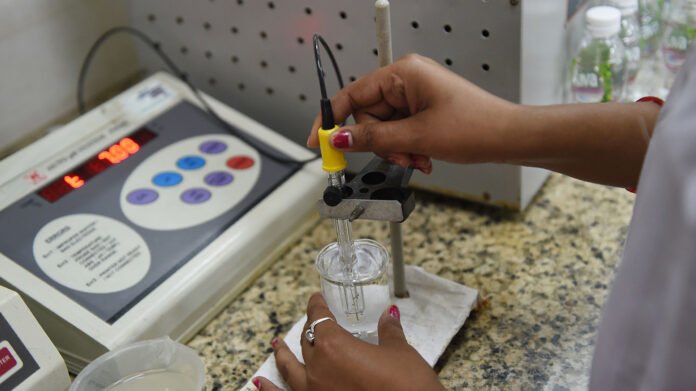Senior government and industry leaders will gather in Washington in late October for annual meetings between the World Bank and the International Monetary Fund (IMF). Water and digital solutions are among the World Bank’s top priorities under its Global Challenge programs and are expected to be highlighted during the meetings.
India has a unique opportunity to build on global momentum and use artificial intelligence (AI) to transform its water and sanitation sectors. National policies have thus far proven ineffective in integrating technology with utilities at scale. However, AI can help government overcome challenges within the water, sanitation and hygiene (WASH) value chain for utilities.
India needs to take three steps to modernize the WASH ecosystem: deploy and scale AI to address non-revenue water (NRW), increase private sector participation, and improve corporate reporting.
Set the context
NRW is water that is produced but cannot be billed because it is lost before it reaches customers or there is no mechanism to bill for it. As of 2019, NRW costs the world $39 billion and India $5 billion annually. This problem stems from inadequate planning, flawed systems, inefficient operation of utilities – including theft, under-billing and non-payment by users – and a lack of funding for infrastructure modernization. Indian utilities can leverage AI to avoid identity redundancies and minimize NRW.
India’s NRW ranges between 31 and 38 percent, exceeding the global average of 30 percent. The Atal Mission for Rejuvenation and Urban Transformation (AMRUT) 2.0, which covers 60 percent of the urban population, which is 22 percent of Indians, aims to reduce the NRW for cities to below 20 percent. However, this objective is not mandatory, but an incentive.
The Jal Jeevan Mission, launched by the Modi government in 2019 for rural areas, prioritized adoption of technology to provide tap water connections to every household and improve governance. NITI Aayog, the central policy committee, and various ministries and departments have developed India’s national AI strategy, rules, and use cases. At the same time, states and cities are tackling their own water problems. For example, Karnataka has set up an AI task force to monitor groundwater levels in Bengaluru. AI implementation for WASH, specifically for NRW, needs to be streamlined for efficiency.
Using AI to tackle NRW
There are existing use cases for reducing NRW using digital technologies. For example, Japan has managed to reduce its NRW from 22.0 percent in the 1970s to 7.3 percent in the early 2000s. To achieve this, Japan has developed a national policy and guidelines for leakage control and prevention, as well as a robust enforcement mechanism. Advanced technological interventions, including acoustic methods, automatic leak detectors, data triangulation detectors, Internet of Things sensors and AI, were deployed to monitor water distribution systems.
Implementing a similar system in India will enable the government to identify leakages, improve planning, reduce NRW and earn lost revenue. These revenues could then be reinvested in India’s underfunded water infrastructure, expanding services to communities that currently lack access to water and wastewater networks.
Rethinking private sector participation
Increasing private sector participation in the sector is crucial. A recent World Bank report highlights that the global water and sanitation sector faces an annual financing gap of $131.4 billion to $140.8 billion, with only 2 percent of investment coming from private players. To attract new investment, government policies and programs must provide opportunities to mitigate risks and implement innovative engagement models.
There are numerous global examples of effective public-private partnerships. Ofwat, the UK’s water regulator, has established a $522 million innovation fund to support AI-powered systems to improve the operational resilience of water systems to climate change.
The New York City Department of Environmental Protection and the Partnership Fund for NYC launched the Environment Tech Lab (ETL) in 2023 to leverage the global technology sector to solve challenges in its water and wastewater network. ETL is currently working with startup ecosystems to rapidly test, support, and incubate new technologies, including AI-focused solutions.
A national fund to encourage and reduce the risks of private sector participation in WASH in India will go a long way. There are numerous private players equipped to implement solutions. However, the government must also take into account supporting community involvement for successful implementation.
Improving corporate reporting on water resources
Water use data is limited in India due to voluntary environmental reporting requirements by companies. The Securities and Exchange Board of India’s Business Responsibility and Sustainability Report (BRSR) Core will require sustainability information for the 1,000 largest companies by market capitalization from March 2024, including information on water and energy consumption, waste, greenhouse gas emissions and others. While this approach is a positive step, it excludes several companies and does not provide a solution for streamlining reporting.
Comprehensive and enforceable reporting could improve transparency. Advanced generative AI platforms can benefit both companies and regulators by improving sustainability reporting. There are several technology providers active in the space. For example, NASDAQ’s Environmental, Social, and Governance (ESG) AI solution builds on regulatory and voluntary reporting on ESG and is already widely deployed in the United States. India can use a similar approach to modernize reporting, making it easier for companies to report and for the government to assess.
AI can revolutionize the water sector, reducing costs and increasing access. To implement scalable solutions, policymakers should focus on uniform legislation, NRW reduction using AI, private sector investment and data reporting.
Bhawna Prakash is a senior fellow for water and sanitation with the chair in India and Emerging Asia Economics at the Center for Strategic and International Studies in Washington, DC





